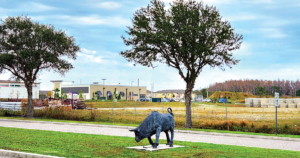
As traffic continues to back up daily a few miles north of New Tampa at the S.R. 56 exit from I-75 in Wesley Chapel — where the area’s newest outlet mall is set to open — state transportation officials are considering alternatives for reworking the I-75 interchange at S.R. 56 to improve the flow of traffic.
The Florida Department of Transportation (FDOT) has approved funding in its 2016-17 budget for the study and design of a new interchange concept for S.R. 56. The likely scenario is a new one that many drivers probably have not seen before, but is becoming a more popular alternative that has helped increase traffic flow, as well as improved safety, on bridges above and/or the roads below interstate highways.
Called a “diverging diamond” interchange (DDI), FDOT is considering an idea that would place drivers on what typically would be considered the “wrong side of the road.” However, using traffic signals and signage, the concept is supposed to make busy interchanges more efficient and safer.
According to FDOT, it works like this: If you’re headed north on I-75 and you get off at S.R. 56, you’ll approach the stop light at the interchange. If you’re headed east, nothing changes. But, if you’re headed west, you should definitely not be texting and should definitely pay attention to the road. Instead of crossing the eastbound lanes of S.R. 56 and turning left onto the westbound lanes, which is the current set-up, you’ll immediately turn left.
After crossing the interstate and approaching the stoplight at the entrance to the southbound lanes of I-75, you’ll then cross back over into what are the normal westbound lanes on the northern side of the road. Traffic on S.R. 56 headed in either direction follows the signs to the opposite lanes for the length of the bridge and then switches back to normal lanes at the next stoplight.
If you feel yourself going cross-eyed, check out the diagram (right).
FDOT reports that DDIs create fewer conflict points for vehicles, offer better visibility during turns and cut back on the opportunities for drivers to enter the interstate in the wrong direction. In addition, DDIs provide free or simple left and right turns from all directions, increase left turn capacity (where traffic usually is the worst during the afternoon rush when getting off I-75 at the S.R. 56 interchange) without needing more lanes; they also cut traffic signals down to two cycles and improve traffic signal synchronization.
DDIs also are a cheaper alternative than rebuilding an interchange, FDOT says. In fact, the existing bridge should support a DDI and additional right-of-way is rarely needed. Plus, the construction time is significantly reduced and traffic patterns don’t have to be significantly altered while the interchange is being transformed. Lanes just have to be shifted, instead of new ones being constructed.
The S.R. 56 interchange has transformed at an exponential rate since it was first constructed in 2002. Traffic back-ups onto the interstate became so extreme that the current two-mile-long new exit ramp had to be constructed and opened in 2012 to handle the traffic, which will increase exponentially when the mall opens in October.
Although there are no DDIs currently in operation in our area, one currently is under construction in the Sarasota area at the University Pkwy. interchange. However, instead of creating a DDI on a bridge (as would be the case at S.R. 56), the Sarasota DDI is being constructed under the interstate bridge.
For more information, please visit DOT.State.fl.us.




No comment yet, add your voice below!